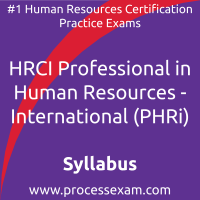 To achieve the professional designation of HRCI Professional in Human Resources - International from the HRCI, candidates must clear the PHRi Exam with the minimum cut-off score. For those who wish to pass the HRCI HR Professional in Human Resources - International certification exam with good percentage, please take a look at the following reference document detailing what should be included in HRCI HR Professional in Human Resources - International Exam preparation.
To achieve the professional designation of HRCI Professional in Human Resources - International from the HRCI, candidates must clear the PHRi Exam with the minimum cut-off score. For those who wish to pass the HRCI HR Professional in Human Resources - International certification exam with good percentage, please take a look at the following reference document detailing what should be included in HRCI HR Professional in Human Resources - International Exam preparation.
The HRCI PHRi Exam Summary, Sample Question Bank and Practice Exam provide the basis for the real HRCI Professional in Human Resources - International (PHRi) exam. We have designed these resources to help you get ready to take HRCI Professional in Human Resources - International (PHRi) exam. If you have made the decision to become a certified professional, we suggest you take authorized training and prepare with our online premium HRCI HR Professional in Human Resources - International Practice Exam to achieve the best result.
HRCI PHRi Exam Summary:
| Exam Name | HRCI Professional in Human Resources - International |
| Exam Code | PHRi |
| Exam Fee | USD $395 |
| Application Fee | USD $100 |
| Exam Duration | 135 Minutes plus 30 minutes administration time |
| Number of Questions | 115 |
| Passing Score | 78% |
| Format | Multiple Choice Questions |
| Books / Trainings | Training |
| Schedule Exam | Pearson VUE |
| Sample Questions | HRCI HR Professional in Human Resources - International Exam Sample Questions and Answers |
| Practice Exam | HRCI Professional in Human Resources - International (PHRi) Practice Test |
HRCI HR Professional in Human Resources - International Syllabus Topics:
| Topic | Details | Weights |
|---|---|---|
| Business Management |
- Using information about the organization and business environment to reinforce expectations, influence decision making, and avoid risk. Responsibilities:
|
14% |
| Workforce Planning and Talent Acquisition |
- Identifying, attracting, and employing talent while following all local laws related to the hiring process. Responsibilities:
|
14% |
| Learning and Development |
- Contributing to the organization’s learning and development activities by implementing and evaluating programs, providing internal consultation, and providing data. Responsibilities:
|
10% |
| Total Rewards |
- Implementing, promoting, and managing compensation and benefit programs that attract and retain talent while complying with local laws. Responsibilities:
|
15% |
| Employee Engagement |
- Developing, communicating, and enhancing employee engagement initiatives to support optimal employee performance management activities throughout the employee lifecycle. Responsibilities:
|
17% |
| Employee and Labor Relations |
- Manage, monitor, and/or promote legally compliant programs and policies that impact the employee experience. Responsibilities:
|
20% |
| HR Information Management |
- Tools, technology, and systems that efficiently optimize the organization’s access to its human resource data. Responsibilities:
|
10% |
Both HRCI and veterans who’ve earned multiple certifications maintain that the best preparation for a HRCI PHRi professional certification exam is practical experience, hands-on training and practice exam. This is the most effective way to gain in-depth understanding of HRCI HR Professional in Human Resources - International concepts. When you understand techniques, it helps you retain HRCI HR Professional in Human Resources - International knowledge and recall that when needed.
